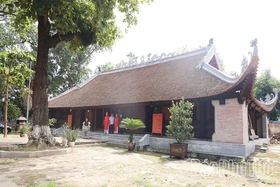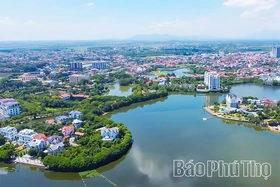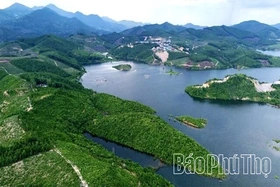{title}
{publish}
{head}
The newly expanded Phu Tho possesses a vast geographical area bordering the capital city of Ha Noi, with a well-connected transport infrastructure and a diverse topography that stretches from midlands and mountains to lowlands.
This unique setting brings together three distinctive cultural regions: the sacred Ancestral Land of the Hung Kings, the legendary Muong Hoa Binh cultural area, and the modern, misty land of Tam Dao – Vinh Phuc. These three “cultural streams” converge into a continuous flow of history, culture, and nature, forming a solid foundation for comprehensive tourism development. They also serve as the basis for creating high-quality tourism products such as spiritual “back-to-the-origin” tours, eco-tourism, wellness and resort tourism, community tourism associated with the cultural identities of the Muong, Thai, Dao, and Cao Lan ethnic groups, as well as sports, golf, and MICE tourism.

The Hung Temple palanquin procession attracts large numbers of visitors every year.
As the land of national origin, Phu Tho has long been a prominent cultural and spiritual destination. The Hung Temple Special National Historical Relic Site—symbolizing the Hung Kings Worship Belief recognized by UNESCO as a Representative Intangible Cultural Heritage of Humanity—serves as a spiritual convergence point, connecting Vietnamese communities at home and abroad. Alongside it, invaluable heritages such as Xoan singing, Ca tru, the Tugging Ritual and Game, and the Worship of the Mother Goddesses of the Three Palaces contribute to a distinct cultural identity that captivates both domestic and international visitors.
Beyond its cultural depth, the expanded Phu Tho region is also a land of ecological richness and ideal resorts. Xuan Son National Park—where the majestic Hoang Lien Son range meets crystal-clear streams—serves as the “green lung” of the region, home to rare ecosystems and ethnic Dao and Muong communities preserving their pristine traditions. Meanwhile, Hoa Binh Lake Tourist Area, Thanh Thuy Hot Mineral Spring Resort, Ao Chau Lagoon, Ly Lake, Tam Dao, and Dai Lai stand out as perfect getaways for travelers seeking relaxation and harmony with nature. These are golden assets for developing eco-tourism, wellness, and community-based tourism—forms increasingly favored by both domestic and international visitors.
Hoa Binh, the cradle of the globally renowned “Hoa Binh Culture,” bears witness to humanity’s long evolutionary journey. The rich Muong cultural identity is expressed through the sounds of bronze gongs, traditional stilt houses, folk festivals, and community tourism models in Lac Village, Ke Hamlet, and Mo Hamlet—attracting hundreds of thousands of tourists each year. Its system of lakes, caves, forests, and the rare Kim Boi hot spring source provide a foundation for developing adventure, health, and luxury resort tourism. Meanwhile, Vinh Phuc—often called the “Da Lat of the North”—exudes a modern charm with the romantic Tam Dao, French colonial architecture, golf courses, and international-standard resorts. The leisure space of Dai Lai, the Flamingo complex, and high-end entertainment centers have positioned Vinh Phuc as an ideal destination for mid- to high-end and international travelers.
To elevate tourism development in proportion to its potential and expectations, Phu Tho needs to implement synchronized and effective groups of key solutions. Building on the expanded spatial foundation formed after the merger of Phu Tho, Vinh Phuc, and Hoa Binh, tourism development is not only an opportunity but also an urgent requirement to transform this land into one of the most distinctive tourism centers in northern Vietnam.
With its expanded space, rich cultural and ecological potential, and a systematic, determined development strategy, Phu Tho now stands before a golden opportunity to become a diverse and sustainable tourism hub of the North—enhancing the position of the Ancestral Land on the national and regional tourism map.
Anh Tho

baophutho.vn From a land blessed with poetic landscapes—where the Da River reservoir meets the distinct Muong cultural identity—Thung Nai Commune is...

baophutho.vn Nestled in the lush green valley of Thung Nai Commune, Mo Hamlet appears like a rustic painting, where traditional stilt houses rest beside...

baophutho.vn The vibrant colors of Pa Co Market, located in Pa Co Commune, are woven together from the radiant beauty of brocade fabric, the bright smiles...

baophutho.vn After the administrative merger, Phu Tho Province has entered a new development phase with great potential in culture and tourism. The province...

baophutho.vn Amid the tranquil valley of Mai Chau, where stilt houses nestle beside rice fields and green bamboo forests, there is a small haven called...

baophutho.vn As dusk falls, Tam Dao slips into a new attire - soft, misty and dreamlike. In that brief moment, it transforms into a romantic hideaway where...

baophutho.vn Located in the heart of Tho Tang commune – a region once famous as the "village market town," Tho Tang Communal House quietly preserves the...

baophutho.vn Dam Vac is often likened to a “green jewel” for its vital role in regulating the climate and reducing flooding in Vinh Yen and Vinh Phuc wards....

baophutho.vn One October weekend, we came to Xoan Retreat in Mo Hamlet, Da Bac Commune, Phu Tho Province. Far removed from the image of a typical resort,...

baophutho.vn After the merger, the new Phu Tho province has opened up a vast development space with abundant potential, especially in tourism.